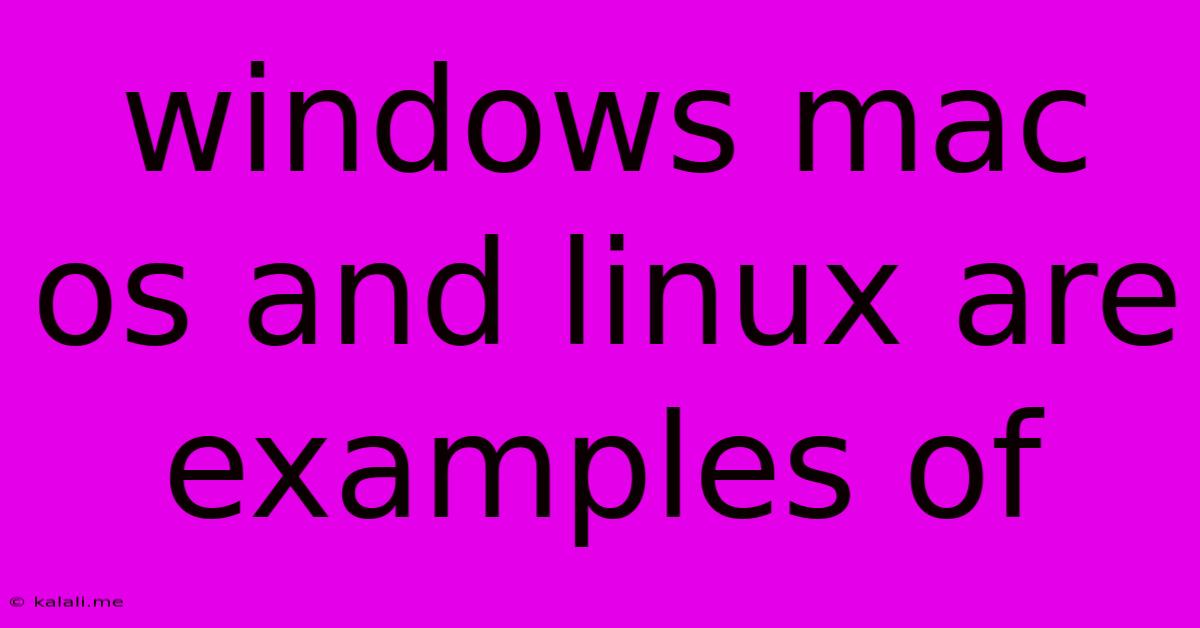Windows Mac Os And Linux Are Examples Of
Kalali
Jun 12, 2025 · 3 min read

Table of Contents
Windows, macOS, and Linux: Examples of Operating Systems
Meta Description: Windows, macOS, and Linux are all examples of operating systems, the fundamental software that manages computer hardware and resources. This article explores their key differences and similarities.
Operating systems are the unsung heroes of the computing world. Without them, your computer would be a useless hunk of metal and plastic. They're the fundamental software that manages all your computer's hardware and resources, allowing you to interact with your device and run applications. Windows, macOS, and Linux are three of the most prominent examples, each with its own strengths and weaknesses. This article will delve into what makes them operating systems and highlight their key differences.
What is an Operating System (OS)?
Before diving into specifics, let's define what an operating system actually is. An OS acts as an intermediary between the user and the computer's hardware. It performs crucial tasks such as:
- Managing hardware: This includes controlling the CPU, memory, storage devices, and input/output devices (keyboard, mouse, etc.).
- Running applications: The OS provides the environment necessary for software programs to execute.
- Providing a user interface: This allows users to interact with the computer, whether through a graphical user interface (GUI) like Windows or a command-line interface (CLI).
- Managing files and folders: The OS organizes and manages files and directories on storage devices.
- Providing security: The OS incorporates security features to protect the system from malware and unauthorized access.
Windows: The Dominant Player
Windows, developed by Microsoft, holds the largest market share among desktop operating systems. Known for its user-friendly GUI and vast software compatibility, it's a popular choice for home users and businesses alike. However, it's also known for its higher price point compared to its open-source counterparts and its vulnerability to malware. Key features include:
- Wide software compatibility: A massive library of software is available for Windows.
- User-friendly interface: Generally considered intuitive and easy to learn.
- Strong gaming support: The vast majority of PC games are developed for Windows.
- Proprietary software: Requires purchasing a license.
macOS: The Apple Ecosystem
macOS, Apple's operating system for its Macintosh computers, is known for its sleek design, user-friendly interface, and tight integration with other Apple devices. It's often praised for its stability and security, but its higher price point and limited software compatibility compared to Windows can be drawbacks. Key features include:
- Seamless Apple ecosystem integration: Works flawlessly with iPhones, iPads, and other Apple devices.
- Elegant and intuitive interface: Known for its clean design and ease of use.
- Strong focus on security and privacy: Apple prioritizes user security and data protection.
- Limited software compatibility: Fewer software options compared to Windows.
Linux: The Open-Source Alternative
Linux is a family of open-source operating systems known for its flexibility, customization, and strong community support. It's a popular choice among developers, system administrators, and users who value control and customization. While it can have a steeper learning curve than Windows or macOS, its versatility and cost-effectiveness make it a powerful option. Key features include:
- Open-source and free: Completely free to use and distribute.
- Highly customizable: Users can tailor the system to their specific needs.
- Strong community support: A large and active community provides assistance and support.
- Excellent for servers: Widely used for web servers and other server applications.
Conclusion: Choosing the Right Operating System
Windows, macOS, and Linux all serve as examples of robust operating systems, each catering to different user needs and preferences. The "best" operating system depends entirely on individual priorities: ease of use, software availability, cost, and level of customization all play a role in making the right choice. Understanding the core functionalities of an operating system helps users make an informed decision based on their specific requirements.
Latest Posts
Latest Posts
-
Which Earthquake Waves Are The Fastest
Jun 13, 2025
-
Router Works In Which Layer Of Osi Model
Jun 13, 2025
-
Choose The Correct Html Tag For The Largest Heading
Jun 13, 2025
-
What Is The Difference Between Sodium Bicarbonate And Sodium Carbonate
Jun 13, 2025
-
Which Of The Following Is Not An Antibiotic
Jun 13, 2025
Related Post
Thank you for visiting our website which covers about Windows Mac Os And Linux Are Examples Of . We hope the information provided has been useful to you. Feel free to contact us if you have any questions or need further assistance. See you next time and don't miss to bookmark.